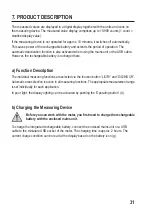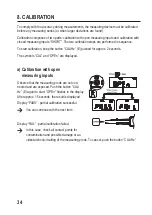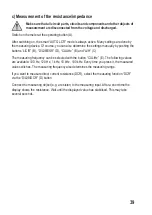
37
11. MEaSuRINg
do not exceed the maximum permitted input voltage. do not touch any
circuits or parts of circuits if they may be subject to voltages higher than
33 V/aCrms or 70 V/dC! danger to life! Before measuring, check meter for
damage such as a broken housing.
If “OL” (overload) appears on the display, you have exceeded the measuring range.
Perform calibration before any measuring series to warrant accuracy. Calibration is
described in detail in chapter 8.
a) Measuring the Inductivity
Make sure that all circuit parts, circuits and components and other objects of
measurement are disconnected from the voltage and discharged.
Switch on the meter at the operating button (A).
After switching on, the smart “AUTO LCR” mode is always active. Many settings are done by
the measuring device. Of course, you can also determine the settings manually by pushing the
buttons “L/C/R” (B), “D/Q/θ/ESR” (D), “CAL/Hz” (E) and “Δ/H” (C).
The measuring frequency can be selected with the button “CAL/Hz” (E). The following values
are available: 100 Hz, 120 Hz, 1 kHz, 10 kHz, 100 kHz. Every time you press it, the measured
value switches. The measuring frequency also determines the measuring range.
To return to AUTO mode, push the button “L/C/R/DCR” (B) for approx. 3 seconds.
Connect the measuring object (coil) to the measuring input. After a short time the display
shows the inductivity. Wait until the displayed value has stabilised. This may take several
seconds.
















































